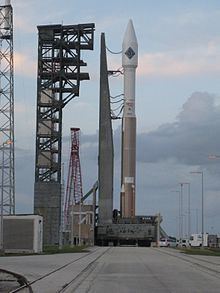Short name SLC-41 Status Active Launch pad 1 | Min / max
orbital inclination 28° - 57° Operator United States Air Force Total launches 84 | |
 | ||
First launch 21 December 1965
Titan IIIC / LES-3/4 Last launch 20 January 2017
Atlas V / SBIR-GEO 3 Associated
rockets Titan IIIC (past)
Titan IIIE (past)
Titan IV (past)
Atlas V (current)
Vulcan (2019) Launch site Cape Canaveral Air Force Station Similar Cape Canaveral Air Force, Cape Canaveral Air Force, Cape Canaveral Air Force, Kennedy Space Center La, Spaceport Florida Launch C | ||
Cape Canaveral Air Force Station Space Launch Complex 41 (SLC-41), previously Launch Complex 41 (LC-41), is an active launch site at the north end of Cape Canaveral, Florida at Cape Canaveral Air Force Station. The site is currently used by United Launch Alliance (ULA) for Atlas V launches. Previously, it had been used by the Air Force, for Titan III and Titan IV launches. In the future, the pad will be used to launch the partly-reusable Vulcan launch vehicle. It is expected to launch for the first time in 2019.
Contents
Titan III
The Titan III launch facilities at CCAFS were built as part of an Integrate-Transfer-Launch approach intended to enable a rapid launch rate. Titan vehicles were assembled and integrated with their payloads off-pad and then transported by rail to one of the two pads. The Titan III facilities included both LC-40 and LC-41, assembly buildings including the Vertical Integration Building, and the first rail line at the Cape. The facilities were completed in 1964, and the first launch from LC-41 was of a Titan IIIC, carrying four separate payloads, on December 21, 1965.
Titan IV
LC-41 was also the pad used for the maiden flight of the Titan IV. The last Titan launch from LC-41 was on April 9, 1999, when a Titan IVB launched the USA 142 early warning satellite. The IUS upper stage failed to separate, leaving the payload stranded in a useless GTO orbit.
Atlas V
After the last Titan launch, the complex was renovated, and since 2002, LC-41 has been used by ULA for Atlas V launches. The maiden flight of Atlas V launched from LC-41 on August 21, 2002. The Atlas V booster lifted Hot Bird 6, a Eutelsat geostationary communications spacecraft built around a Spacebus 3000B3 bus.
Until 2005, Atlas V rockets were assembled vertically on a mobile launch platform in the Vertical Integration Facility, once located to the south of the pad. The platform was transported to the launch pad on rails, about a day before launch.
Modifications for supporting human spaceflight
In September 2015, pad modifications began to support human spaceflight via the Boeing CST-100 Starliner capsule.
Modifications include the addition of a launch service tower to provide access to the capsule for "pre-launch processing, crew access, and safety egress systems should the need to evacuate Starliner on the pad occur."
Payloads
In addition to satellites, Titan vehicles launched several probes from LC-41 in the 1970s, including the Helios probes to study the Sun, the Viking probes to Mars, and the Voyager planetary flyby and deep-space probes. More recent probes have also been launched from LC-41 using the Atlas V: the Mars Reconnaissance Orbiter in December 2004, the New Horizons spacecraft to Pluto in January 2006, The Juno mission to Jupiter in August 2011, and The Mars Science Laboratory to Mars in November 2011.
